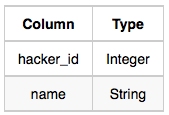문제
Julia asked her students to create some coding challenges. Write a query to print the hacker_id, name, and the total number of challenges created by each student. Sort your results by the total number of challenges in descending order. If more than one student created the same number of challenges, then sort the result by hacker_id. If more than one student created the same number of challenges and the count is less than the maximum number of challenges created, then exclude those students from the result.


내 풀이
SELECT HC.HACKER_ID
, HC.NAME
, CH.TOTAL
FROM HACKERS HC
INNER JOIN (
SELECT HACKER_ID
, COUNT(CHALLENGE_ID) AS TOTAL
FROM CHALLENGES
GROUP BY HACKER_ID
HAVING COUNT(CHALLENGE_ID) IN (
SELECT BT.TOT
FROM (
SELECT A.TOTAL AS TOT
, COUNT(A.TOTAL) AS CNT
FROM (
SELECT HACKER_ID
, COUNT(CHALLENGE_ID) AS TOTAL
FROM CHALLENGES
GROUP BY HACKER_ID
) A
GROUP BY A.TOTAL
HAVING COUNT(A.TOTAL) = 1
OR A.TOTAL = (
SELECT MAX(TEMP.TOTAL) AS CNT
FROM (
SELECT HACKER_ID
, COUNT(CHALLENGE_ID) AS TOTAL
FROM CHALLENGES
GROUP BY HACKER_ID
) TEMP
)
) BT
)
) CH
ON HC.HACKER_ID = CH.HACKER_ID
ORDER BY TOTAL DESC
, HACKER_ID ASC강사님 풀이 1
SELECT HC.HACKER_ID
, HC.NAME
, COUNT(*) AS CHALLENGES_CREATED
FROM CHALLENGES CH
INNER JOIN HACKERS HC ON CH.HACKER_ID = HC.HACKER_ID
GROUP BY HC.HACKER_ID, HC.NAME
HAVING CHALLENGES_CREATED = ( SELECT MAX(CHALLENGES_CREATED)
FROM (
SELECT HACKER_ID
, COUNT(*) AS CHALLENGES_CREATED
FROM CHALLENGES
GROUP BY HACKER_ID
) SUB )
OR CHALLENGES_CREATED IN ( SELECT CHALLENGES_CREATED
FROM (
SELECT HACKER_ID
, COUNT(*) AS CHALLENGES_CREATED
FROM CHALLENGES
GROUP BY HACKER_ID
) SUB
GROUP BY CHALLENGES_CREATED
HAVING COUNT(*) = 1)
ORDER BY CHALLENGES_CREATED DESC, HACKER_ID강사님 풀이 2: WITH 사용
-- 재사용 가능한 테이블 만들기
WITH COUNTER AS (
SELECT HACKERS.HACKER_ID
, HACKERS.NAME
, COUNT(*) AS CHALLENGES_CREATED
FROM CHALLENGES
INNER JOIN HACKERS ON CHALLENGES.HACKER_ID = HACKERS.HACKER_ID
GROUP BY HACKERS.HACKER_ID, HACKERS.NAME
)
SELECT *
FROM COUNTER
WHERE CHALLENGES_CREATED = ( SELECT MAX(CHALLENGES_CREATED) FROM COUNTER)
OR CHALLENGES_CREATED IN ( SELECT CHALLENGES_CREATED
FROM COUNTER
GROUP BY CHALLENGES_CREATED
HAVING COUNT(*) = 1)
ORDER BY CHALLENGES_CREATED DESC, HACKER_ID728x90
'SQL' 카테고리의 다른 글
| 서브쿼리(Subquery)의 종류 (0) | 2022.03.17 |
|---|---|
| NL조인의 특징 (0) | 2022.03.17 |
| 왜 조인 메소드를 선택할 때 NL조인을 가장 먼저 고려해야 할까? (0) | 2022.03.17 |
| Join의 종류(NL, Sort Merge, Hash) (0) | 2022.02.17 |
| Leetcode 267 (0) | 2020.10.24 |
댓글